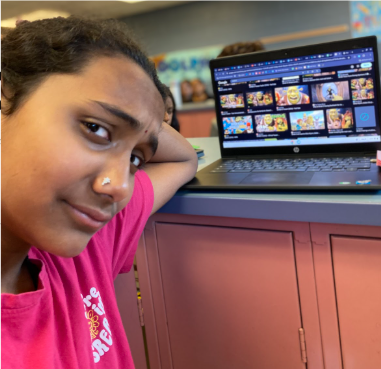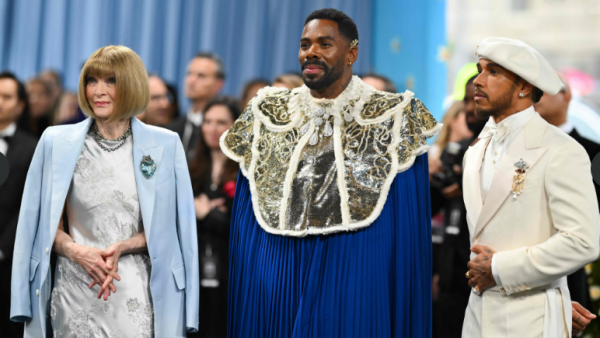The road to ‘Dark Road’
Behind Carson’s gloomiest fall production to date.
The aura is vibrant and curious, the white light flickering from the stage further exacerbating the feel. Then the lights dim and teenage performers line up near the back wall, and the mood turns solemn. The lights flick on again, no longer a sharp white, but rather a dull blood-red. A single character steps forward, and a hush falls over the crowd, replaced by quiet anticipation.
This is the beginning of “Dark Road”—the fall production directed and acted by Mr. Joshua Bickford’s Advanced Drama students.
“When I signed up to be the technical director I was expecting to work a happy fun play so I had trouble with a dark topic like this,” Alara Lay, an eighth-grader on the Wolves team who served as the technical director for the play, said.
Dark Road tells the story of a young woman named Greta, living in Nazi Germany. She hears that a nearby women’s concentration camp is hiring guards. She jumps at the chance, looking at it as a chance to solidify her face in society and provide for her family—primarily, her sister, Lise. Soon, however, she learns the truth about what she must do as a guard—and learns as well how to justify her crimes so as to lull herself into complacency, heading further down the “Dark Road” that she has paved for herself.
It was a long road to get to where “Dark Road” eventually ended up. There were a lot of notes that Mr. Bickford had that the actors had to iron out, so it was pretty difficult to do in such a small period of time. The dark subject matter didn’t help things either—actors had to make sure that everything was note-perfect so that they could do justice to the solemn—but important—subject matter.
A large part of that was making sure that the show looked and sounded right—dark and ominous, inspiring a sense of on-the-edge-of-your-seat foreboding. The brunt of that fell on one person: the technical manager.
“I get to pick the sounds and lights and background. It’s kind of my little superpower,” says Alara Lay, who—as the technical manager of “Dark Road”—served as the director of lights and sound. She’s the one who orchestrated the powerful beginning—the blood-red in place of a sharp white, a single spotlight perfectly placed as to instigate a sense of cautious awe.
But Alara was hardly the only one to work on cultivating that type of environment about the stage.
“I think we all had to work together as a drama class to make this production—especially in such a short period of time. It really was a team effort, for sure,” says Maria Craig, an eight-grader on the Dolphins team, the stage manager of “Dark Road.” She worked on blocking, working with actors, and organizing the semicircle of people that hugged the back wall during the play. “Part of it was the actual play, for sure, but part of it was just getting the right mindset for actually being in the play. In a play this serious, you have to be really, really professional. We couldn’t really laugh on stage, and not bringing your a-game wasn’t an option. We had to do justice to the source material.”
Getting the point of “Dark Road” was the team’s challenge—one that provided its own host of problems. Chief among them was not only how to deal with the source material, but how to make sure that it works.
“One thing that was really fun and that helped us a lot was talking with the actual playwright of ‘Dark Road,’” says Alara. “That really helped me figure out how to go about making the show. She helped me realize that black, red, and white were really this show’s colors—something really stark in contrast to all the muddled morality that we explore in the show—and that the music should be slow, somber, and powerful.”
Meeting the playwright also helped the actors with how to work through the play correctly and put as much as they could of themselves into their characters.
“It really helped the actors understand how to portray their characters—and how to, you know, personalize them as well—and she helped me understand how to talk through the characters with separate actors,” says Maria. “That’s one of the big things that really helped us get the show together in time.”
Work on the play started in September leading to a performance not even two months later.
“Even though it was kind of rushed, I think it was really worth it,” says Maria. “All my friends and family told me how great they thought it was. Kids I never knew came up to me. My grandma even cried during the play. I think it’s touched a lot of people. I think it was really difficult to work through and it got really sad at times, but people really related to its message and what it was saying.”
Chief among the people that “Dark Road” touched were those that were involved intimately in it—the countless other Marias and Alaras that worked behind-the-scenes.
“The play, I think, really opened up the inner activist in me,” says Alara. “I’ve noticed things happening in the world before, but I’ve never really thought about doing something about it. Now, though, in ‘Dark Road’ the character looks silently at all the injustices and does nothing about it, and she lets the darkness take control. I don’t want that to happen to me—or anyone, so I’m going to speak up.”
Difficult as “Dark Road” was, those who worked on it believe that it was a powerful tool with an everlasting message.
“I think what “Dark Road” teaches us is that there’s ample good and evil in everyone. We have to work to keep that delicate balance. We can’t let the—well, the ‘Dark Road’—become the road that we choose to follow,” Maria says. “There’s so much bad stuff in the world. People are dying, the refugee situation, the opioid crisis—we have an obligation to do what’s right.”

Vishwa Rakasi is a seventh-grader on Legacy. In his spare time, he dabbles in screenwriting, regular writing, poetry, and competitive swimming. His favorite...
Rehaan is a seventh-grader on the Legacy Team. In his free time he plays the bassoon and competitive volleyball. His favorite classes are history and English.








